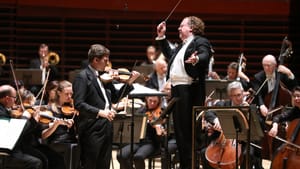Stay in the Loop
BSR publishes on a weekly schedule, with an email newsletter every Wednesday and Thursday morning. There’s no paywall, and subscribing is always free.
John Williams, Beethoven, and Ravel, all in good company
Philadelphia Orchestra continues its celebration of John Williams

Everyone wants to do something other than what they’re known for doing. Actors want to direct, chefs want to skydive, film composers want to write symphonies. Sometimes it works, sometimes not, but in the case of John Williams, vocation and avocation go hand in hand.
The Philadelphia Orchestra has been celebrating the symphonic music of John Williams this season. No, not the usual pastiche of Star Wars favorites, but actual classical compositions the multi-Grammy and Academy Award-winning composer penned during a long lifetime (he’s 84 and still going strong).
So, tell me: if you won a nomination and an Academy Award for the scores to Valley of the Dolls and Fiddler on the Roof some 50 years ago, wouldn’t you call it a day, retire to Acapulco, drink mai tais, and play the banjo? Au contraire, this composer is inexhaustible. Williams has gone on to win more awards for more hummable scores than you can shake a baton at.
However, few Williams fans know that the creator of many film scores has a secret life as a composer of contemporary classical music. You can search examples on YouTube, but there is nothing like the warm, living presence of a composer’s ideas as expressed through the medium of a symphonic organism as sensitive and supple as the Philadelphia Orchestra.
I was not looking forward to this event. It rained for a week, and here was a concert that opened with a pavane to a dead princess followed by an elegiac concerto in memory of Williams’ late wife. The program would conclude with Beethoven’s Symphony No. 7, a great work, but one I have heard in concert twice in the past month.
Fortunately, I followed my mantra (“Have tickets? Attend!”), and am so glad I did. The Williams Violin Concerto, composed in the mid-1970s, is one of those rare large works of contemporary music which appeal to listeners ranging from conservative to avant-garde. The orchestra lingers over an atonal passage or startles with a rash of loud discords, but generally sweeps us along in a gush of neo-romantic elegance.
This work is very compartmentalized, with three distinctly drawn movements (fast, slow, fast), and significant pauses between them. Partly through Stéphane Denève’s skillful direction, the orchestra never shouts down its soloist. (Denève is this season’s principal guest conductor.) Part of this elegant balance between violinist and orchestra is also incorporated in Williams’ thoughtful writing, which not only allows us to hear what the violinist has to say, but also highlights the important voice of the orchestra and its solo instrumentalists, notably woodwinds, French horn, a tangy assortment of percussion, and harp.
Elegant as it is, this work would not fare well without an extraordinary violinist such as Canada’s remarkable James Ehnes. I hesitate to call him a virtuoso, since that term suggests a flashy, in-your-face bravado utterly foreign to his style, but there is no doubt of his technical mastery. Yet, it is not his flawless technique that elevated this performance, but rather the seamless flow, dynamic richness, and interpretative insight that Ehnes brought to individual passages and to his vision of the work as a whole.
Thanks to Ehnes’s insight, the cadenza at the end of the first movement holds its heartbreaking, uplifting own with some of the greatest in the violin repertoire. Few contemporary cadenzas move from such a depth of feeling, and I think we can thank Ehnes, even more than Williams, for a few moments when emotion and intelligence coalesced into art.
After intermission, the great Beethoven took center stage. I thought the symphony was off to a weak start, but it may have been Denève’s insistence on highlighting the classical, rather than the romantic. However, this first movement was a shadow of what was to come. The celebrated second movement (repeated twice when first performed under Beethoven’s baton in 1813) warmed as the variations grew in intensity. The third movement was rollicking, but the fourth exploded into a kind of planned, escalating hysteria, leaving audiences gasping for breath.
Did I mention the pavane? Yes, it was Ravel’s perfect six-minute miniature, “Pavane for a Dead Princess,” very familiar and not nearly as sad as the title suggests. At the end of a lovely rendition, just as Denève was about to bow his head for a moment’s silence before turning to accept applause, a phone rang, and no one was in a hurry to pick it up. Denève waited it out, and only then, did he begin the moment of true silence before turning to the audience. Listeners near me murmured their appreciation. Like fine Chinese landscape painting, music, too, needs negative space in which to thrive.
What, When, Where
Philadelphia Orchestra: John Williams, Violin concerto; Ludwig Van Beethoven, Symphony No. 7; and Maurice Ravel, "Pavane for a Dead Princess." Stéphane Denève conductor. James Ehnes, violinist. May 6, 2016 at the Kimmel Center's Verizon Hall, Broad and Spruce Sts., Philadelphia. (215) 893-1999 or philorch.org.
Sign up for our newsletter
All of the week's new articles, all in one place. Sign up for the free weekly BSR newsletters, and don't miss a conversation.

 Linda Holt
Linda Holt